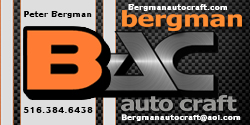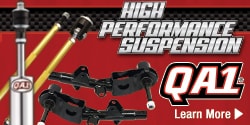After Market Universal Wiring Harness & Fuse Block?
- Thread starter coalman
- Start date
-
I don't think the year makes much difference really. Once the old wiring harness is gutted it's pretty much just a shell. I used the EZ wire and have no complaints at all. Good quality. Not a Plug & Play a little electrical experience is definitely a bonus.
I don't think the year makes much difference really. Once the old wiring harness is gutted it's pretty much just a shell. I used the EZ wire and have no complaints at all. Good quality. Not a Plug & Play a little electrical experience is definitely a bonus.
Thanks for your input..
J Glenn
Well-Known Member
Someone had replaced mine before I got the car. They used a fuse block that 'looked' like the factory one showed in the repair manual, but it wasn't the same. The one they used had one power input feeding to all the fuses.. The factory one had a few different circuits contained within the fuse block... so watch for that.
Ed Kelly
Well-Known Member
I used the Ron Francis Express Kit when I rewired my 64 Dart Wagon. This is a great kit with easy to follow instructions.
Bill Crowell
Well-Known Member
I prefer to rebuild the original fuse block because it makes troubleshooting much easier when using the FSM schematics. The parts for the fuse block are getting more difficult to find, but they are available. I also like to rebuild the old wiring harnesses with the same color wire as the original, and in some circuits with a slightly larger-gauge wire.
i printed out the wiring pages and have drawn in the new fuse panel and what factory wires i connected toI prefer to rebuild the original fuse block because it makes troubleshooting much easier when using the FSM schematics.
i printed out the wiring pages and have drawn in the new fuse panel and what factory wires i connected toView attachment 1715546992
Thanks, I guess that is two sheets, just a little hard to read. I meant to ask you what fuse panel you used, and were you happy with it? Thanks
Last edited:
just meant the paperwork as an example of what i did to keep track of the changes i made to the wiring. i added a bunch of gauges, moved the battery to the trunk, headlight relays and just generally made a mess of the stock wiring, so i have a pretty thick pile of notes in case i ever need to trace out what i didThanks, I guess that is two sheets, just a little hard to read. I meant to ask you what fuse panel you used, and were you happy with it? Thanks
just meant the paperwork as an example of what i did to keep track of the changes i made to the wiring. i added a bunch of gauges, moved the battery to the trunk, headlight relays and just generally made a mess of the stock wiring, so i have a pretty thick pile of notes in case i ever need to trace out what i did. i used the one i linked to. i decided where i wanted to mount it (on top of the tunnel under the dash, so i can get to the fuses easy), and used the FSM to decide which circuits in the stock fuse block needed battery hot or run hot, and cut over one at a time to the new fuse block.
Thanks again, I am looking at two types the one pre-wired, and the ones you wire it yourself.
Cuda416
Well-Known Member
I think a good approach is to restore the factory stuff, but make the changes required in the engine bay to drive high current things with relays and not rely on heavy current going through little connectors on the firewall.
I think a good approach is to restore the factory stuff, but make the changes required in the engine bay to drive high current things with relays and not rely on heavy current going through little connectors on the firewall.
Thanks for your input, I have done the MADD bypass and have an extra wire from the Alternator to the starter relay, if that is what you are referring to. Thanks again
Cuda416
Well-Known Member
Thanks for your input, I have done the MADD bypass and have an extra wire from the Alternator to the starter relay, if that is what you are referring to. Thanks again
Not sure what MADD is but headlights, electric fan, electric fuel pump, starter, etc. Anyway, food for thought. Best of luck
no MADD here, i'm still running the ammeter, which i opened up, inspected and made sure the connections where tight. but like Cuda416 say's, the direct current to feed big load items (H4 headlights and A/C), gets fed through relays, and so have their own inline fusing. however, the power to trip the relays, the dash lights (LED's), the gauges and tail lights are still on the load side of the ammeter. i don't have anything else electrical, mechanical fan and fuel pump, and stereo by TTi
BillGrissom
Well-Known Member
Somewhat. I rewired the engine compartments in my 1964 Valiant slant and 1965 Dart 273, using a relay/fuse box from a late 1990's Jeep which is long and skinny with 7 relays. I rewired all relays, but had to re-use the wires & terminals since I couldn't source them (fit relay blades, but not Packard 56 terminals). It has ~10 big blade fuses, all powered from a common rail and 6 small blade fuses with isolated terminals (like the relays). I got rid of the factory firewall relays (starter, horn) and ran small ribbon wire from the bulkhead for the wires which just turn on relays now (headlights, ignition, ...). In my 1964, I replaced the bulkhead with one from a 1965 Fury to get the large buss-bar feed-thru's for the thick ALT and BAT wires, which avoids the melting problems of other years (exc. 1963). I am currently doing the same for my 1965 Chrysler, while adding a Holley Commander 950 TBI, and forgot what a chore it is. I have a nice labeler now so at least marking all wires. The cabin wires were still fine in all cars, so I just cleaned up the wiring, fixing messes made by gomers. Search for my post "Modernized wiring ..." for details and photos.
Somewhat. I rewired the engine compartments in my 1964 Valiant slant and 1965 Dart 273, using a relay/fuse box from a late 1990's Jeep which is long and skinny with 7 relays. I rewired all relays, but had to re-use the wires & terminals since I couldn't source them (fit relay blades, but not Packard 56 terminals). It has ~10 big blade fuses, all powered from a common rail and 6 small blade fuses with isolated terminals (like the relays). I got rid of the factory firewall relays (starter, horn) and ran small ribbon wire from the bulkhead for the wires which just turn on relays now (headlights, ignition, ...). In my 1964, I replaced the bulkhead with one from a 1965 Fury to get the large buss-bar feed-thru's for the thick ALT and BAT wires, which avoids the melting problems of other years (exc. 1963). I am currently doing the same for my 1965 Chrysler, while adding a Holley Commander 950 TBI, and forgot what a chore it is. I have a nice labeler now so at least marking all wires. The cabin wires were still fine in all cars, so I just cleaned up the wiring, fixing messes made by gomers. Search for my post "Modernized wiring ..." for details and photos.
Thanks for your input....
chinze57
Push Button tranny and a Slant 6 that'll never die
I used the Ron Francis Express Kit when I rewired my 64 Dart Wagon. This is a great kit with easy to follow instructions.
I’m looking at using the Ron Francis kit for my ‘64 Dart 270. Did you keep the stock gauges and ignition? What modifications did you have to make to accommodate the new harness? It seems that the kit is everything from bumper to bumper, so did you have to remove the connector that bridges the factory engine harness to the underdash harness? Thanks for any help, just trying to figure out what I’m getting myself into
Ed Kelly
Well-Known Member
I’m looking at using the Ron Francis kit for my ‘64 Dart 270. Did you keep the stock gauges and ignition? What modifications did you have to make to accommodate the new harness? It seems that the kit is everything from bumper to bumper, so did you have to remove the connector that bridges the factory engine harness to the underdash harness? Thanks for any help, just trying to figure out what I’m getting myself into
I remove all stock wiring harnesses from headlight to taillights and all points in between. I installed aftermarket oil pressure, temp, fuel and volt meter. Completely bypassed the amp meter and stock gauges.
The only issue I ran into was the ignition switch wiring. The instructions did not spell out the need to wire ING1 and ING2 together. Ron Francis Customer service helped me with that issue.
It is pretty easy to do and the kit is well laid out. You will have enough left over wire to wire another car, as they give you more than enough wire.
- Joined
- Mar 17, 2018
- Messages
- 16,206
- Reaction score
- 39,055
Total and unbiased support for Painless products. I have done several cars with their kits and fuse blocks. Super good product. I then hybrid in a front light harness from a Ron Francis type. Works out very well. Pix is one I am doing currently integrating a modern gen 3 to a 72 Demon. Again a painless fuse block. I can incorporate all different modules if needed, fans, fuel pump etc etc. If you are going back bone stock original the painless may be overkill tho?

chinze57
Push Button tranny and a Slant 6 that'll never die
I remove all stock wiring harnesses from headlight to taillights and all points in between. I installed aftermarket oil pressure, temp, fuel and volt meter. Completely bypassed the amp meter and stock gauges.
The only issue I ran into was the ignition switch wiring. The instructions did not spell out the need to wire ING1 and ING2 together. Ron Francis Customer service helped me with that issue.
It is pretty easy to do and the kit is well laid out. You will have enough left over wire to wire another car, as they give you more than enough wire.
Have you done the HEI mod to your 64, as I am aware that it requires you wire IGN1 and IGN2 together then.
If you have any pictures of the process or the end result I would appreciate those
BillGrissom
Well-Known Member
I have on several of my old Mopars. One needs to do so for any modern ignition which tosses the ballast resistor. I connected IGN and IGN2 at the key switch terminal, using spade jumpers so I didn't permanently bugger the factory wires. It is easy to release the pins w/ a thin screwdriver, though I use the correct tool for 57 terminals. I repurposed the IGN2 wire for my AC compressor (previously run thru a hole in firewall, dealer-AC I think) since bulkhead terminals are limited and valuable. Easier is to just jumper across the ballast resistor. No problem for me using the smaller IGN wire since it turns on an underhood relay to provide IGN power.Have you done the HEI mod to your 64, as I am aware that it requires you wire IGN1 and IGN2 together then.
If you have any pictures of the process or the end result I would appreciate those
-
















